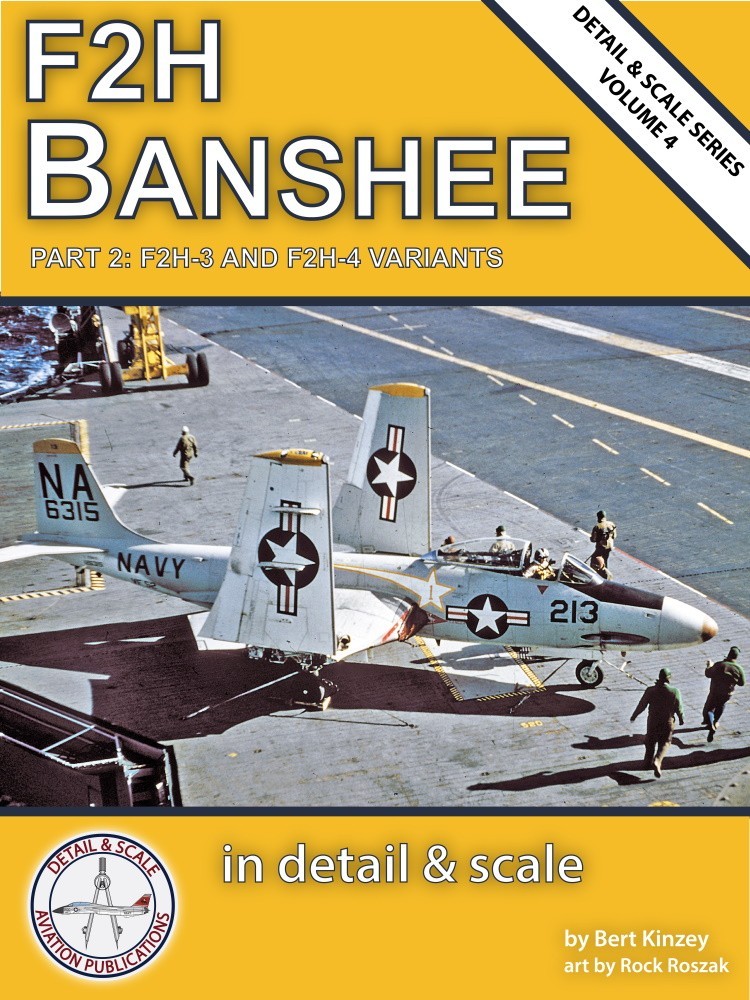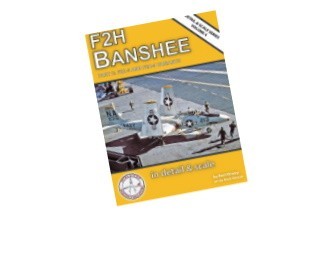
Introduction
F2H Banshee in Detail & Scale, Part 2: F2H-3 and F2H-4 Variants
Last year Detail & Scale launched F2H Banshee in Detail & Scale, Part 2: F2H-3 and F2H-4 Variants, a follow-up to their 2016 release F2H Banshee in Detail & Scale, Part 1: Prototypes Through F2H-2 Variants. Richly supported with photographs and artwork, F2H Banshee in Detail & Scale, Part 2 is available in three formats:
1. Print: 103 pages, 282 photos (170 in color), 15 color profiles
2. Apple and Kindle: 265 pages, 290 photos (261 in color), 26 color profiles
3. The print issue is catalogued as ISBN 9798704312192
Detail & Scale is known for producing focused monographs of aviation subjects, primarily focused on specific historical and physical characteristics of an aircraft. Authors Bert Kinzey and Rock Roszak bring over 60 years of first-hand military aviation experience to their titles. Both are also modelers, obvious by their detailed survey of kits of the“Big Banshee.”
The Banshee Details chapter includes more than 120 photographs and illustrations covering the aircraft extensively inside and out. Among the nine different sections of this chapter is one on the weapons certified for use on the F2H-3 and F2H-4, as well as the under-wing stations on which they were carried. A large majority of the photographs in the Banshee Details chapter were taken specifically for this publication.
“The McDonnell F2H Banshee holds a unique place in the annals of United States naval aviation. Like its contemporaries in the North American FJ Fury and the Grumman F9F Panther, the original design evolved into a significantly different aircraft.”
Three distinct sections present the evolution of the F2H from a clear air mass fighter into the all-weather “Big Banjo,” as pilots nicknamed the enlarged F2H. The only foreign operator of the Big Banjo was Canada, a history covered as closely as American ”Big Banjoes.” Changes and modifications through the development of the F2H are documented and examined. Operators are listed by squadron. It also focuses on the multiple paint – and paintless – schemes used on the Banshee.
Content
F2H Banshee In Detail & Scale, Part 2: F2H-3 and F2H-4 Variants is covered through 103 pages with 23 chapters and sections:
Introduction
Developmental History
Banshee Variants
- F2H-3
F2H-4
Canadian Banshees
- Natural Metal Finish
Aluminum Lacquer Scheme
Gloss Sea Blue Scheme
Light Gull Gray Over Insignia White Scheme
Royal Canadian Navy Paint Scheme
- Cockpit Details
Windscreen & Canopy Details
Fuselage Details
Internal Armament Details
Wing Details
Pylon & External Stores Details
Landing Gear Details
Tail Details
Engine Details
Introduction explains this book as the follow-on of D&S’ first Banshee book published in 2016, and the story of developing the capabilities of the F2H. Recognition of those who provided content to make this book what it is.
Developmental History presents a brief and by no means cursory overview of the development and deployment of radar and nightfighters in the U.S. Navy in World War Two. The stage set, we learn about nightnighter development in the early jet age. Equipment types with designations are introduced, i.e., AN/APS-19A search radar and the re-contouring of the jet’s nose, which led to the F2H-2 becoming the F2H-2N, and the efforts to design and field a purposed-built nightfighter, designated without the “N” suffix. Also mentioned were new second-generation Navy jets designs and the Banshee’s service with them. Technical details are presented such as guns, airframe modifications, dihedral changes, fuel capacity, and drop tank fittings and unique preflight handling of some external tanks. Flight performance and engine upgrades are covered, as is aerial refueling, complete with plumbing. A brief account of Banshee carrier service is mentioned, both for USN and Canadian F2Hs.
Thirteen pages later we learn of Banshee Variants. Each variant is concisely covered with a page of text, and several pages of photographs and artwork supported with information rich captions, arranged in order of squadron designation. Production numbers are recounted as well as the units who flew big Banjoes, even listing some carrier cruises. This illuminates the operational histories of the jet in fulfilling the needs of different units,and fate of those that did not.
Eighteen pages later, Banshee Paint Schemes treats us to an appraisal of the multiple US and Canadian paint schemes, and fascinating experimental finishes; McDonnell’s F2H family gained attention as carrier-based jets left in a natural metal finish. How their many finishes were conceived, and succeeded or failed, makes an intriguing read. This chapter is 17 pages and covers the concepts, reasons, and reports for trying unpainted aircraft. Evaluation results are offered and subsequent decisions presented. Each paint scheme, Natural Metal Finish, Aluminum Lacquer Scheme, Gloss Sea Blue Scheme, Light Gull Gray Over Insignia White Scheme, and Canada’s Dark Sea Gray and Light Sea Gray is represented with original artwork, and black-and-white or color photographs. Unique color demarcations are verified with photographs.
Next starts Banshee Details, a 41-page feast for the eyes of original up close and personal color detail photos of key areas of the big Banshee:
Cockpit Details: eight pages; six photographs; seven illustrations based on NATOPS manual (see below).
Windscreen & Canopy Details:two pages with four photos.
Fuselage Details: nine pages and 29 photos and illustrations.
Internal Armament Details: a page with four photos or illustrations showing the 20mm cannon installation, keyed to eight items.
Wing Details: Seven pages, 20 images; closeups of the perforated speed brake and wing fold hinge areas are particularly valuable; fascinating are the photos of navigation lights on the leading edges of tip tanks.
Pylons & External Stores Details: three pages, 11 photos and drawings.
Landing Gear Details: six pages, 20 images.
Tail Details: two pages, eight photos.
Engine Details: two pages with five photos and an illustration.
That chapter allows modelers to examination Banshee colors in high-detail photos. Speaking of models, both authors are modelers and end their books with Modelers Section. This section looks in-depth at scale models for the F2H-3/-4 family, including notes on inaccuracies and aftermarket parts. “Big Banjoes” are not well represented in scale, with only a handful of kits in1/48, 1/72 and 1/144. Commentary accompanies several of the model reviews including speculation that one company may not releases a follow-on variant due to the flaws of their first subject. Each subject presents a built model. It notes that one of the best kits of the large F2H is a resin kit from a defunct company.
If one wants to know about the state of late F2H models, this book covers can inform you if your choice may be a mistake, or a gem.
Photographs, Artwork, Graphics
Visual support of the scholarly text consists of a large gallery of period and recent photography, original artwork by co-author Roszak, and graphics. The photos are high-quality with clear focus and good development. Over 170 photos are in color, excellent source material for modelers. One color photo blows away any idea that all USN jets were immediately touched up when the paint wore away. An image of a blue Banshee with red flap interiors, white and yellow markings on a weathered carrier deck inspires a diorama. These images are useful to differentiate between different metals on the natural metal finish (NMF) Banshees as well as between those and aluminum-painted F2Hs.
Artwork
1. Antenna Locations identifies electrical sensors for a multitude of systems on the airframe, keyed to 11 components, with notes concerning specific serial ranges incorporating A.S.C. orders.
Profiles
- F2H-3:
- 2. VF-23 “The Flashers,” NMF, USS Essex, 1954.
3. BuNo. 126425, Gloss Sea Blue (GSB), VF-31 “Tomcatters,” Gloss Sea Blue (GSB), USS Midway, 1954.
4. BuNo. 126425, NMF, VF-41 “Black Aces,” USS Randolph, 1955.
5. BuNo. 126470, VF-64 “Freelancers,” USS Shangri-La, 1956-57.
6. BuNo. 126362, VF-71 “Hell’s Angels,” NMF, USS Bennington, 1953-54.
7. BuN0. 126433, VF-141, GSB, USS Randolph, 1953.
8. BuN0. 127533, VF-152 “Fighting Aces,” Light Gull Gray over white (GGW), 1956.
9. VF-193 “Ghostriders,” GGW, Yorktown, 1957.
- VF-11 “Red Rippers,” GSB.
10. BuNo. 127690, VF-22 “Cavaliers,” GGW, 1957.
11. BuNo. 127590, VF-71 “Hell’s Angels,” GGW, USS Randolph, 1958-59.
12. BuNo. 127603, VF-82 “Iron Men,” GSB.
13. BuNo. 127536, VF-102 “Diamondbacks,” GSB, USS Randolph, 1956.
14. VMF-214 “Black Sheep,” GGW, USS Hancock, 1957.
15. BuNo. 127661, VMF-533 “Black Diamonds,” NMF, 1954.
16. BuNo. 127669, Reserve Training Unit NAS Oakland, GGW and high-visibility orange.
- VF-871, Royal Canadian Navy (RCN), 1958, Dark Sea Gray and Light Sea Gray (DLS), 1958.
17. VF-870, RCN, Dark Sea Gray and Light Sea Gray.
18. Test SQN VX-10, RCN, Dark Sea Gray and Light Sea Gray.
19. Natural Metal Paint Scheme Diagrams: standard specifications and markings for F2H-3 and -4 shown in profile, top, and underside, illustrated to show different colored panels.
20. Aluminum Lacquer Scheme Diagrams: standard specifications and markings for aluminum-painted jets shown in profile, top, and underside, noting special paints used.
21. Overall Gloss Sea Blue Paint Scheme Diagrams: standard specifications and markings for gloss sea blue jets shown in profile, top, and underside, noting special paints and colors used.
22. Non-specular Light Gull Gray Over Insignia White Paint Scheme Diagrams: standard specifications and markings for gray and white jets shown in profile, top, and underside, noting special paints and colors used.
23. Royal Canadian Navy Paint Scheme Diagrams: standard specifications and markings for gloss sea blue jets shown in profile, top, and underside, noting special paints and colors used.
24. Main Instrument and Pedestal Panels: created using F2H-3/-4 NATOPS manual, this 3D illustrates and identifies 40 dials, gauges, handles, switches, etc., and four pieces of equipment installed in certain serials of aircraft or modifications.
25. F2H-3 Left Console: keyed to 49 items, with three pieces of equipment installed in certain serials of aircraft or modifications.
26. F2H-4 Left Console: keyed to 52 items and a different panel incorporated in a modification.
27. F2H-3 Right Console (early) : keyed to 65 items, mainly electrical gear, and a different panel incorporated in a modification.
28. F2H-3 (late) and F2H-4 right Console: effective after serial 126300, keyed to 68 items, two modified panels, and notes.
29. Ejection Seats: keyed to 42 components.
30. Westinghouse APQ-41 Radar: based on the F2H-3/-4 manual, keyed to 26 components.
31. Hughes APG-37 Radar: based on the F2H-3/-4 manual, keyed to 31 components.
32. Internal Armament Details: 20mm cannon installation, keyed to eight items.
33. AAM-N-7A Sidewinder and Universal Rocket Launcher.
34. Westinghouse J34 Turbojet Engine: 3D showing engine with apparatus, keyed to 15 components.
Tables
1. Electric systems other than radar: AN number, component code and system name, i.e., UHF Command radio being the AN/ARC-27.
2. F2H-3 Squadrons lists squadron numbers, squadron nicknames, tail code(s) and notes for 21 squadrons.
3. F2H-4 Squadrons lists squadron numbers, squadron nicknames, tail code(s) and notes for 16 squadrons.
4. F2H-3 & F2H-4 Conventional Stores Capabilities: eight weapon stations keyed to six types of munitions.
Such an excellent gallery of images leaves little uncovered visually.
Conclusion
F2H Banshee in Detail & Scale, Part 2: F2H-3 and F2H-4 Variants from Detail and Scale is another excellent history of the Navy’s first all-weather jet fighter. Thoroughly researched, expertly written, richly illustrated, detailed, is should be a must-have for historians and modelers of the F2H-3 and F2H-4. Many of the scenes in photographs of the big Banshees call out to be modeled. The modeling section can help you decide =which F2H-3/-4 is for you, which are inaccurate, and why.
The F-2H-3/-4 hold a special place in Naval aviation and this book does the “Big Banjo” justice. I am happy to have this book on my shelf and recommend it to enthusiasts, historians and modelers of the aircraft. Recommend.
Please remember to mention to Detail & Scale and retailers that you saw this product here - on Aeroscale.

